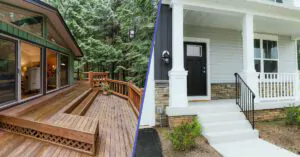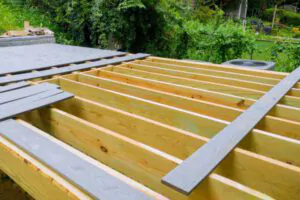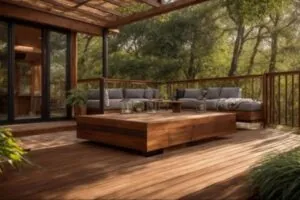
As homeowners, envisioning your outdoor space is a crucial part of creating a comfortable and inviting environment. When it comes to expanding your living space outdoors, understanding the difference between a porch and a deck is essential. These terms are often used interchangeably, but they refer to distinct structures with unique purposes and characteristics.
Definition: Porch vs. Deck

A porch is an exterior structure with a roof that extends from a building’s front, back, or side. It acts as a transition zone between indoor and outdoor areas, offering a covered spot for relaxation and socializing. Often adorned with columns, porches enhance a building’s appearance while providing weather protection. On the other hand, a deck is an elevated outdoor platform that extends beyond ground level. Designed to expand living space, decks accommodate activities like dining and sunbathing. Unlike porches, decks lack roofs and are often positioned to capture scenic views.
The key distinction lies in their intended purposes. Porches create a sheltered link between indoors and outdoors, fostering a cozy retreat. Decks, conversely, serve as open extensions of living spaces, accommodating diverse recreational pursuits. Whether you favor the seamless transition of a porch or the versatility of a deck, understanding these differences empowers you to create an outdoor space tailored to your preferences and lifestyle.
Where are the Porch and Deck Located?
Porches are commonly found at a house’s front, back, or side. Front porches welcome guests, while back porches offer seclusion. Side porches extend adjacent rooms. Decks, on the other hand, are often placed at a house’s rear, capitalizing on views and nature. They also serve as seamless transitions from upper-level rooms. When choosing between a porch and a deck, factors like sunlight, wind direction, and privacy matter. Your chosen location shapes the space’s functionality and comfort.
Is there a Difference in their Construction and Materials?

When constructing porches, a strong foundation and integrated walls create structural unity with the house. Porch floors, commonly wood, concrete, or brick, reflect durability and style. Decks, conversely, rest on supports, elevating them. Their structural separation from the house offers design freedom.
Decking materials, including wood and composite options, offer versatile aesthetics and durability choices. The distinction in construction approaches results in unique characteristics for porches and decks, influencing their appearance, integration, and functionality.
Due to their design, porches are often subject to stricter structural requirements and codes, given their proximity to the house. Decks have lighter load-bearing requirements and may not require the same level of structural reinforcement.
Related Post: Wood Vs. Composite Decking
What is the Difference with their Attachment Process?

Porches are typically attached to the house using various methods, including ledger boards, anchors, and framing. The attachment process involves securing the porch’s structural elements to the existing building.
Decks are also attached to the house using ledger boards, which provide a secure connection. However, because decks are often raised above ground level, additional support systems such as posts and footings are required.
The attachment process for both porches and decks requires careful planning and consideration of load distribution, water drainage, and proper fastening techniques to ensure stability and safety.
Which Last Longer? A Porch or A Deck?
Porches, being more integrated with the house, may require regular maintenance to address issues such as rot, pest infestations, and weather-related damage. Paint or stain applications may also be needed to protect porch materials.
Decks are exposed to the elements and may require regular cleaning, staining, or sealing to prevent decay, fading, and splintering. Additionally, the choice of deck material can influence maintenance requirements.
The durability and lifespan of both porches and decks depend on the materials used. While porches may have longer lifespans due to their integrated construction, proper maintenance significantly extends the lifespan of both structures.
Conclusion
Understanding the difference between a porch and a deck empowers homeowners to make informed decisions about creating their ideal outdoor space. The choice between a porch and a deck hinges on your lifestyle, preferences, and the functional requirements of the space. By considering factors such as location, purpose, construction, and maintenance, you can design an outdoor area that complements your home and lifestyle. Whether you opt for the cozy ambiance of a porch or the expansive versatility of a deck, your outdoor oasis awaits, ready to provide relaxation, entertainment, and lasting memories.
Cape May County Deck Builders’ Expertise

All Pro Cape May Deck Builders is here to help you with all of your decking needs. Professional craftsmanship goes into making unique decks that look like they were always a part of the house. Our team makes sure that your outdoor space is built to last and looks great from start to finish so you can enjoy it and increase the value of your home. Call us today to see how we can breathe new life into your home!
FAQs: Porch vs. Deck
Is a deck and a porch the same thing?
No, a deck and a porch are not the same thing. A porch is a covered structure attached to the front, back, or side of a house, acting as a sheltered transition between indoor and outdoor spaces. A deck, on the other hand, is an open, elevated platform typically located at the rear of a house, designed for outdoor activities like dining or relaxing in the sun.
Can you call a deck a porch?
While some people use the terms interchangeably, a deck is not technically a porch. A porch is always covered and often more integrated with the structure of the house, while a deck is usually uncovered and serves as an open outdoor living space. Using the proper term depends on the structure’s design and purpose.
What is classified as a deck?
A deck is classified as an elevated platform attached to a house or standing independently, designed for outdoor living. Decks are typically constructed from wood, composite materials, or other weather-resistant materials. Unlike porches, decks usually lack a roof and are built to maximize exposure to sunlight and scenic views.
What makes a porch a porch?
A porch is defined by its covered design and close integration with the house. It serves as a transitional space between indoors and outdoors, often at the front of the house to welcome guests or at the back for more private use. Porches are built on a solid foundation and are often enclosed or partially enclosed with walls, screens, or railings for added comfort and weather protection.



